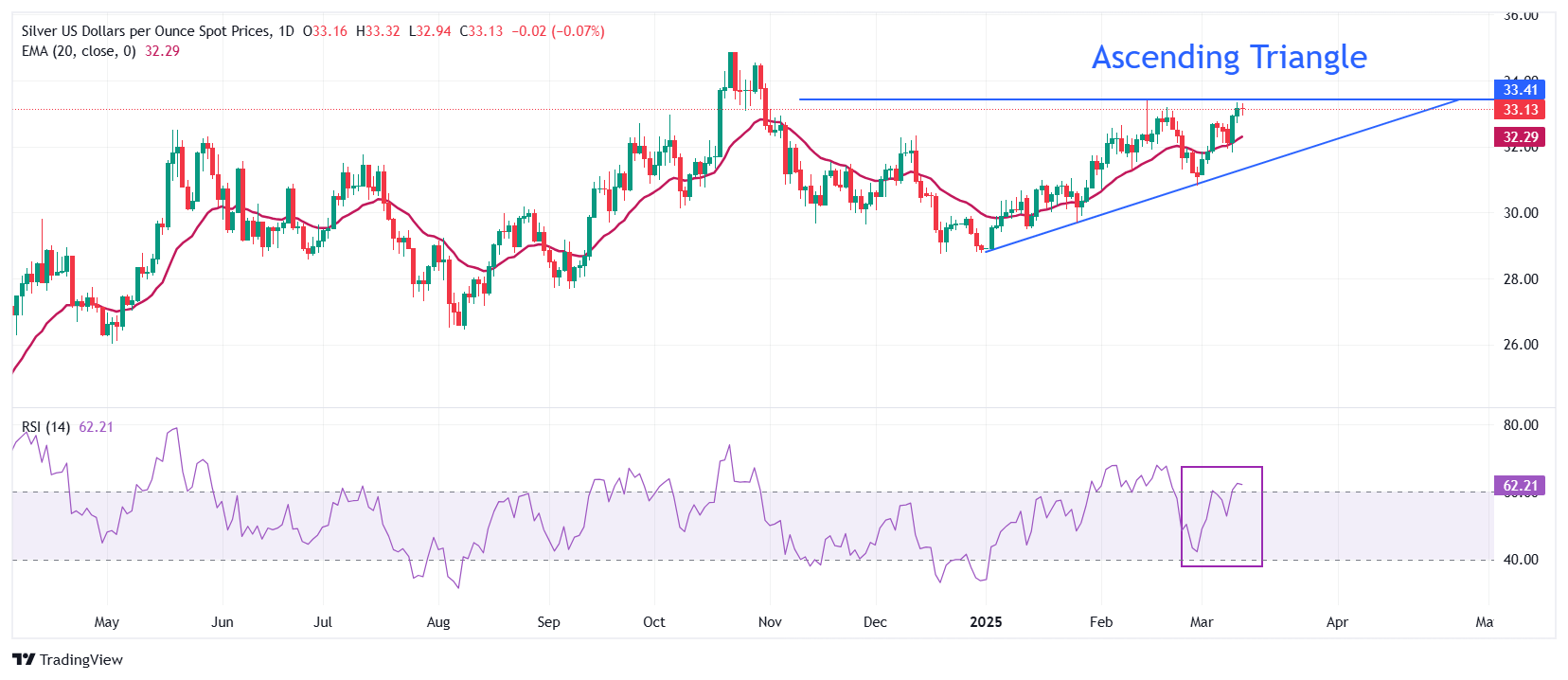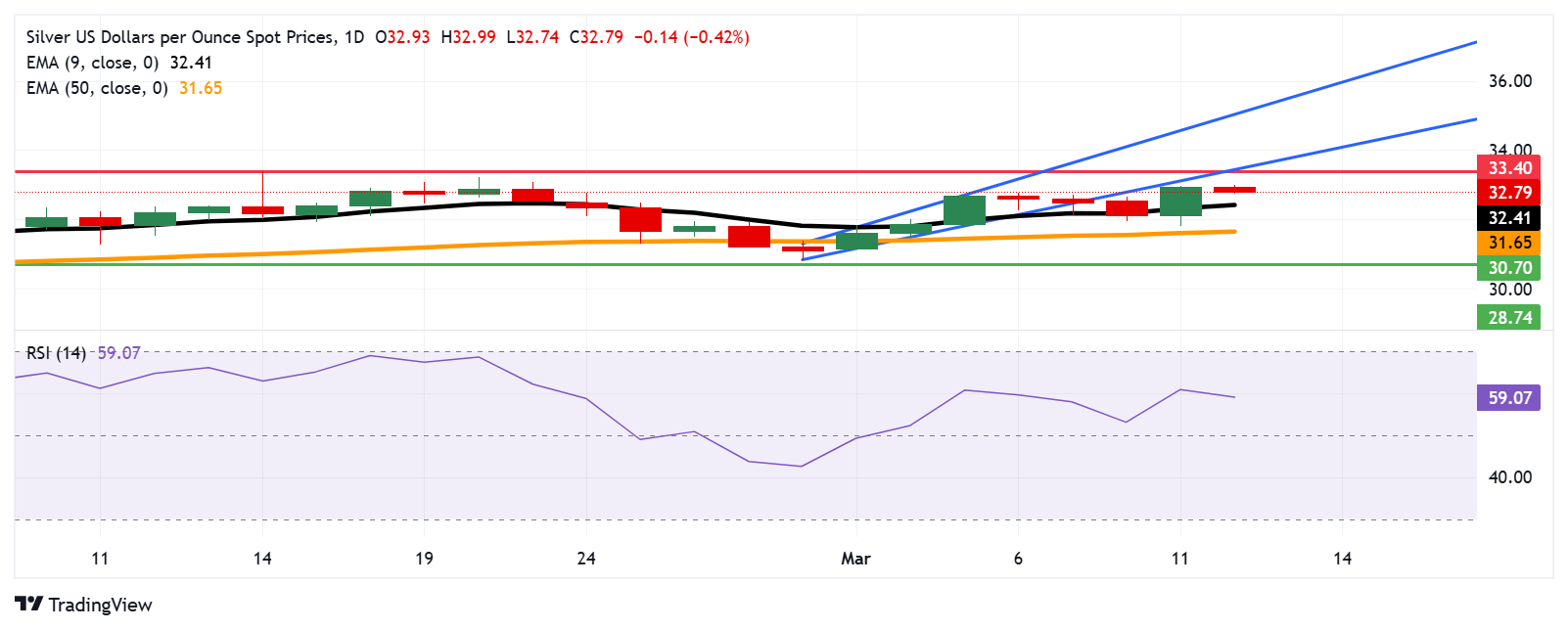- Analytics
- News and Tools
- Quotes
- Chart and quotes for XAGUSD
Quotes and rates for precious metals Silver vs US Dollar (XAGUSD)
| Date | Rate | Change |
|---|
Related news
-
20.03.2025 03:13Silver Price Forecast: XAG/USD remains below $34.00 after Fed rate decision
- Silver price faced headwinds as the Fed maintained the federal funds rate at 4.25%–4.5% on Wednesday
- The non-yielding Silver may have found support as US Treasury yields declined.
- Silver lease rates have surged due to shrinking stockpiles in London.
Silver price (XAG/USD) holds onto gains after a previous session of losses, trading around $33.80 per troy ounce during Asian hours on Thursday. However, the non-interest-bearing metal faces pressure following the Federal Reserve’s (Fed) interest rate decision.
As widely expected, the Fed maintained the federal funds rate at 4.25%–4.5% during its March meeting but reaffirmed its outlook for two rate cuts later this year. This stance aligns with forecasts of slower GDP growth and higher unemployment, counterbalancing concerns over rising inflation in the United States (US), potentially driven by aggressive tariffs imposed by President Donald Trump.
Silver, a non-yielding asset, may have found support as US Treasury yields declined, with the 2-year yield at 3.97% and the 10-year yield at 4.24%. Meanwhile, bonds gained traction following the Fed’s decision to slow the pace of quantitative tightening, citing concerns over reduced liquidity and potential risks tied to government debt limits.
Silver lease rates have surged due to shrinking stockpiles, particularly in London, as Silver flows toward the US to capitalize on higher prices. Banks and traders lease Silver to ensure short-term liquidity for trading or operational needs.
This shift has widened price gaps between major markets, with spot silver up 17% this year, outperforming other commodities. Additionally, physical Silver transfers from Canada and Mexico are strained by tariffs, further tightening supply. Growing fears of a “silver squeeze” could disrupt trade for months.
Silver FAQs
Silver is a precious metal highly traded among investors. It has been historically used as a store of value and a medium of exchange. Although less popular than Gold, traders may turn to Silver to diversify their investment portfolio, for its intrinsic value or as a potential hedge during high-inflation periods. Investors can buy physical Silver, in coins or in bars, or trade it through vehicles such as Exchange Traded Funds, which track its price on international markets.
Silver prices can move due to a wide range of factors. Geopolitical instability or fears of a deep recession can make Silver price escalate due to its safe-haven status, although to a lesser extent than Gold's. As a yieldless asset, Silver tends to rise with lower interest rates. Its moves also depend on how the US Dollar (USD) behaves as the asset is priced in dollars (XAG/USD). A strong Dollar tends to keep the price of Silver at bay, whereas a weaker Dollar is likely to propel prices up. Other factors such as investment demand, mining supply – Silver is much more abundant than Gold – and recycling rates can also affect prices.
Silver is widely used in industry, particularly in sectors such as electronics or solar energy, as it has one of the highest electric conductivity of all metals – more than Copper and Gold. A surge in demand can increase prices, while a decline tends to lower them. Dynamics in the US, Chinese and Indian economies can also contribute to price swings: for the US and particularly China, their big industrial sectors use Silver in various processes; in India, consumers’ demand for the precious metal for jewellery also plays a key role in setting prices.
Silver prices tend to follow Gold's moves. When Gold prices rise, Silver typically follows suit, as their status as safe-haven assets is similar. The Gold/Silver ratio, which shows the number of ounces of Silver needed to equal the value of one ounce of Gold, may help to determine the relative valuation between both metals. Some investors may consider a high ratio as an indicator that Silver is undervalued, or Gold is overvalued. On the contrary, a low ratio might suggest that Gold is undervalued relative to Silver.
-
19.03.2025 21:25Silver Price Forecast: XAG/USD slips below $34.00 as Fed acknowledges uncertainty
-
19.03.2025 09:14Silver Price Forecast: XAG/USD depreciates toward $33.50 ahead of Fed policy decision
-
19.03.2025 04:34Silver Price Forecast: XAG/USD sits near multi-month top, bulls retain control near $34.00 mark
-
18.03.2025 23:06Silver Price Forecast: XAG/USD stalls below $34 as bulls struggle for momentum
-
18.03.2025 10:04Silver Price Forecast: XAG/USD refreshes four-month high around $34 ahead of Fed’s policy decision
-
18.03.2025 04:55Silver Price Forecast: XAG/USD attracts some buyers to near $34.00 on economic uncertainty, geopolitical risks
-
17.03.2025 22:50Silver Price Forecast: XAG/USD hovers near $34.00 as bulls take a breather
-
17.03.2025 08:45Silver Price Forecast: XAG/USD remains close to $34.00 near five-month highs
-
17.03.2025 04:33Silver Price Forecast: XAG/USD holds below $34.00 as traders await US Retail Sales release
-
14.03.2025 07:53Silver Price Forecast: XAG/USD remains solid near $34.00 amid increased safe-haven demand
-
14.03.2025 02:07Silver Price Forecast: XAG/USD keeps the bullish vibe above $33.50 as trade war escalates
-
13.03.2025 12:48Silver Price Forecast: XAG/USD sees upside above $33.40 on soft US PPI and CPI, Trump tariff fears
-
13.03.2025 02:54Silver Price Forecast: XAG/USD rises to near five-month highs, $33.50 level
-
12.03.2025 21:34Silver Price Forecast: XAG/USD shines above $33.00 as US inflation dips
-
12.03.2025 10:17Silver Price Forecast: XAG/USD jumps to near $33 on US slowdown fears, US CPI eyed
-
12.03.2025 03:07Silver Price Forecast: XAG/USD hovers near $33.00, four-month highs
-
11.03.2025 10:25Silver Price Forecast: XAG/USD advances to near $32.50 as USD Index dives on US economic concerns
-
11.03.2025 02:57Silver Price Forecast: XAG/USD rebounds from multi-day low, climbs back above $32.00
-
10.03.2025 21:31Silver Price Forecast: XAG/USD drops as bears eye $32.00
© 2000-2025. All rights reserved.
This site is managed by Teletrade D.J. LLC 2351 LLC 2022 (Euro House, Richmond Hill Road, Kingstown, VC0100, St. Vincent and the Grenadines).
The information on this website is for informational purposes only and does not constitute any investment advice.
The company does not serve or provide services to customers who are residents of the US, Canada, Iran, The Democratic People's Republic of Korea, Yemen and FATF blacklisted countries.
Making transactions on financial markets with marginal financial instruments opens up wide possibilities and allows investors who are willing to take risks to earn high profits, carrying a potentially high risk of losses at the same time. Therefore you should responsibly approach the issue of choosing the appropriate investment strategy, taking the available resources into account, before starting trading.
Use of the information: full or partial use of materials from this website must always be referenced to TeleTrade as the source of information. Use of the materials on the Internet must be accompanied by a hyperlink to teletrade.org. Automatic import of materials and information from this website is prohibited.
Please contact our PR department if you have any questions or need assistance at pr@teletrade.global.




























